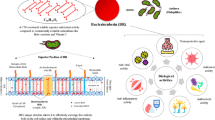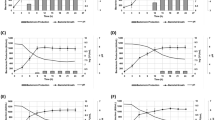Abstract
Fengycin antibiotic displays a strong antifungal activity and inhibits the growth of a wide range of plant pathogens especially filamentous fungi. The main objective of the present study is to characterize fengycin variants produced by B. amyloliquefaciens strain (ET). LC–MS analysis of fengycin extracts has shown several molecular ion peaks corresponding to conventional fengycin homologues (MH + : m/z 1463.9; 1491.9; 1506) and some new ones (MH + : m/z 1433; 1447; 1461; and 1477). Further characterization of these precursor ions was carried out by LC–MS.MS analysis. Reporter fragment ions were observed (named A and B), they correspond to the cleavage of Orn2-Tyr3 (A), Glu1-Orn2 (B), and used for identifying fengycin variants. The reporter fragment couple ions [A/B] at [m/z 966.5/1080.5] and [m/z 994.4 /1108.5] represent fengycin A and B, respectively. The diagnostic ions at ([m/z 980/1094]) may correspond to fengycin C3, D, S or B2. Interestingly, unknown diagnostic product ions at [m/z 951/1065] and [m/z 979/1093] were detected for the first time in this study which prove that they correspond to new fengycin variants, named fengycin X and fengycin Y, respectively. The fengycin X results from a substitution of the glutamine amino acid (Q), at position 8 of the fengycin A peptide part, by an isoleucine (I) or a leucine (L) residue. This mutation should be the same in fengycin Y but compared to fengycin B.






Similar content being viewed by others
References
Abu-Ruwaida AS, Banat IM, Haditirto KA (1991) Nutritional requirements and growth characterization of a biosurfactant producing Rhodococcus Bacterium. World J Microbiol Biotechnol 7:53–61
Kim PI, Bai H, Bai D, Chae H, Chung S, Kim Y, Park R, Chi YT (2004) Purification and characterization of a lipopeptides produced by Bacillus thuringiensis CMB26. J Appl Microbiol 97:942–949
Guoa Q, Dongab W, Lia S, Lua X, Wanga P, Zhanga X, Wangc Y, Maa P (2014) Fengycin produced by Bacillus subtilis NCD-2 plays a major role in biocontrol of cotton seedling damping-off disease. Microbiol Res 169:533–540
Jacques P (2011) Surfactin and other lipopeptides from Bacillus spp. Microbiol Monogr 20:57–91
Ambrico A, Trupo M (2017) Efficacy of cell free supernatant from Bacillus subtilis ET-1, an Iturin A producer strain, on biocontrol of green and gray mold. Postharvest Biol Technol 134:5–10
Alsohim AS, Taylor TB, Barrett GA, Gallie J, Zhang XX, Altamirano-Junqueira AE, Johnson LJ, Rainey PB, Jackson RW (2014) The biosurfactant viscosin produced by Pseudomonas fluorescens SBW25 aids spreading motility and plant growth promotion. Environ Microbiol 16:2267–2281
Nagorska K, Bikowski M, Obuchowki M (2007) Multicellular behaviour and production of a wide variety of toxic substance support usage of Bacillus subtilis as powerful biocontrol agent (review). Acta Biochim Pol 54:495–508
Tao Y, Bie XM, Lv FX, Zhao HZ, Lu ZX (2011) Antifungal activity and mechanism of fengycin in the presence and absence of commercial surfactin against Rhizopus stolonifer. J Microbiol 49(14):6–150
SteinT, (2008) Whole-cell matrix-assisted laser desorption/ionization mass spectrometry for rapid identification of bacteriocin/lantibiotic-producing bacteria. Rapid Commun Mass Spectrom 22(8):1146–1152
Gordillo A, Maldonado MC (2012) Purification of peptides from Bacillus strains with biological activity. Chromatogr Appl 11:201–225
Wang J, Liu J, Wang X, Yao J, Yu Z (2004) Application of electrospray ionization mass spectrometry in rapid typing of fengycin homologues produced by Bacillus subtilis. Lett Appl Microbiol 39:98–102
Yang H, Li X, Li X, Yu H, Shen Z (2015) Identification of lipopeptide isoforms by MALDI-TOF-MS/MS based on the simultaneous purification of iturin, fengycin, and surfactin by RP-HPLC. Anal Bioanal Chem 407:2529–2542
Ongena M, Jacques P (2008) Bacillus lipopeptides: versatile weapons for plant disease biocontrol. Trends Microbiol 16:115–125
Vater J, Kablitz B, WildeC FP, Mehta N, Cameotra SS (2002) Matrix-assisted laser desorption ionization-time of flight mass spectrometry of lipopeptide biosurfactants in whole cells and culture filtrates of Bacillus subtilis C-1 isolated from petroleum sludge. Appl Environ Microbiol 68:6210–6219
International conference of Agriculture, Forrest, Food, and Technologies. 15–17 Mai 2017. Capodocia-Turkey. Source: https://www.scribd.com/document/362824334/Abstract-Proceeding-Book-ICAFOF-2017.
Ait Kaki A, Kacem Chaouche N, Ongena M, AliM K, Dehimat L, Kahlat K, Thonart P (2013) In vitro and in vivo characterization of plant growth promoting Bacillus strains isolated from extreme environments of Eastern Algeria. Appl Biochem Biotechnol 172(4):1735–1746
Jacques P, Hbid C, Destain J, Razafindralambo H, Paquot M, De Pauw E, Thonart P (1999) Optimization of biosurfactant lipopeptides production from Bacillus subtilis S499 by Plackett-Burman design. Appl Biochem Biotechnol 177:223–233.
Bie X, Lu Z, Lu F (2009) Identification of fengycin homologues from Bacillus subtilis with ESI-MS/CID. J Microbiol Methods 79:272–278
Hu LB, Shi ZQ, Zhang T, Yang ZM (2007) Fengycin antibiotics isolated from B-FS01 culture inhibit the growth of Fusarium moniliforme Sheldon ATCC 38932. FEMS Microbiol Lett 272:91–98
Yu Li X, Chao Mao Z, Hu Wang Y, Xing WuY, Qiu He Y, Lin Long C (2012) ESI LC-MS and MS/MS Characterization of Antifungal Cyclic Lipopeptides Produced by Bacillus subtilis XF-1. Mol Microbiol Biotechnol 22:83–93
Lee DW, Kim BS (2015) Antimicrobial cyclic peptides for plant disease control. Plant Pathol J 31:1–11
Esumi Y, Suzuki Y, Itoh Y, Chijimatsu M, Uramoto M, Kimura KI, Nakayama S, Yoshihama M, Ichikawa T, Haramo T, Fujishige J (2003) SNA-60-367 components, new peptide enzyme inhibitors of aromatase: structure of the fatty acid side chain and amino acid sequence by mass spectrometry. J Antibiot 56:716–720
Pathak KV, Keharia H, Gupta K, Thakur SS, Balaram P (2012) Lipopeptides from the Banyan Endophyte, Bacillus subtilis K1: mass spectrometric characterization of a library of Fengycins. J Am Soc Mass Spectrom. https://doi.org/10.1007/s13361-012-0437-4
Vanittanakom N, Loeffler W, Koch U, Jung G (1986) Fengycin a novel antifungal lipopeptide antibiotic produced by Bacillus subtilis F-29-3. J Antibiot 7:888–901
Vater J, Gao X, Hitzeroth G, Wilde C, Franke P (2003) ‘Whole cell’ matrix-assisted laser desorption ionization-time of light-mass spectrometry, an emerging technique for efficient screening of biocombinatorial libraries of natural compounds—present state of research. Comb Chem High Throughput Screen 6:557–567
Liao JH, Chen PY, Yang YL, Kan SC, Hsieh FC, Liu YC (2016) Clarification of the antagonistic effect of the lipopeptides produced by Bacillus amyloliquefaciens BPD1 against Pyricularia oryzae via in situ MALDI-TOF IMS analysis. Molecules 21(12), 21–30.
Villegas-Escobar V, Ceballos I, Mira J, Argel lE, Orduz Peralta S, Tabarez MR, (2013) Fengycin C produced by Bacillus subtilis EA-CB0015. J Nat Prod 76:503–509
De Faria AF, Stéfani D, Vaz BG, Silva ÍS, Garcia JS, Eberlin MN, Grossman MJ, Alves OL, Durrant LR (2011) Purification and structural characterization of fengycin homologues produced by Bacillus subtilis LSFM-05 grown on raw glycerol. J Ind Microbiol Biotechnol 38:863–871
Volpon L, Besson F, Lancelin JM (1999) MR structure of active and inactive forms of the sterol-dependent antifungal antibiotic bacillomycin L. Eur J Biochem 264:200–210
Acknowledgments
The authors are grateful to a fellowships European program Erasmus Mundus External Cooperation Window-consortium AVERROES
Author information
Authors and Affiliations
Corresponding author
Ethics declarations
Conflict of interest
The authors have not declared any conflict of interest.
Additional information
Publisher's Note
Springer Nature remains neutral with regard to jurisdictional claims in published maps and institutional affiliations.
Rights and permissions
About this article
Cite this article
Ait Kaki, A., Smargiasso, N., Ongena, M. et al. Characterization of New Fengycin Cyclic Lipopeptide Variants Produced by Bacillus amyloliquefaciens (ET) Originating from a Salt Lake of Eastern Algeria. Curr Microbiol 77, 443–451 (2020). https://doi.org/10.1007/s00284-019-01855-w
Received:
Accepted:
Published:
Issue Date:
DOI: https://doi.org/10.1007/s00284-019-01855-w




